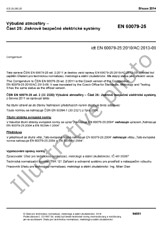We need your consent to use the individual data so that you can see information about your interests, among other things. Click "OK" to give your consent.

IRS 90918-9-2ed.
Digital Security Elements for Rail Passenger Ticketing
Translate name
STANDARD published on 1.6.2022
The information about the standard:
Designation standards: IRS 90918-9-2ed.
Publication date standards: 1.6.2022
SKU: NS-1067247
The number of pages: 99
Approximate weight : 328 g (0.72 lbs)
Country: International technical standard
Category: Technical standards IRS
Annotation of standard text IRS 90918-9-2ed. :
In the past, railway ticketing was protected by means of SiP (Security in Paper) mechanisms. Security was ensured by using a specific type of paper, making it impossible for anyone other than the ticket issuer to print or modify tickets. In international ticketing, the security background - together with legal and functional specifications and frameworks for verification, cancellations and after-sales services - is defined by CIT and ticket layout is defined by UIC to ensure that tickets can be recognised by all railway companies involved. Security in Paper has some limitations: tickets must be printed on special printers with a stock of secured paper applying ticket stock management control, making it difficult to sell tickets over the Internet (fulfilment issues). On the other hand, Security in Paper has the advantage of ensuring that the contract is unique and cannot be duplicated. Any status changes to the ticket can be printed on the ticket itself, applying the amendments to the original contract. Modern ticketing systems using SiD (Security in Data) are defined not only by layout (recognisable to all TCOs involved), but also by the security elements used. These security elements allow TCOs to verify that the content has not been created or modified by anyone other than RUs. Reading/verification must be facilitated without granting the party checking the ticket the right to create the security elements. A so-called asymmetrical security algorithm is used for this purpose. The mechanism of generating AZTEC-barcodes for international ticketing is described in detail for different barcodes that can be used in different situations: - Small Structured Barcodes - Ticket Layout Barcodes - Flexible Content Barcodes. There is also a chapter describing the PDF417-based so-called Element List Barcodes, to allow TCOs to read these barcodes in case other RUs still uses them, since these are less performant and not recommended for future developments. It integrates in full or in part the following UIC leaflets: 918-3 It complements the following standards:
We recommend:
Technical standards updating
Do you want to make sure you use only the valid technical standards?
We can offer you a solution which will provide you a monthly overview concerning the updating of standards which you use.
Would you like to know more? Look at this page.



 Cookies
Cookies
